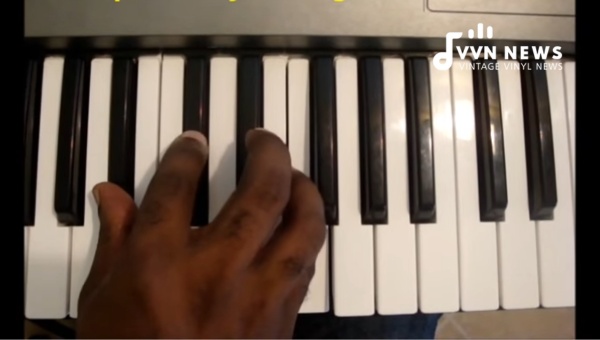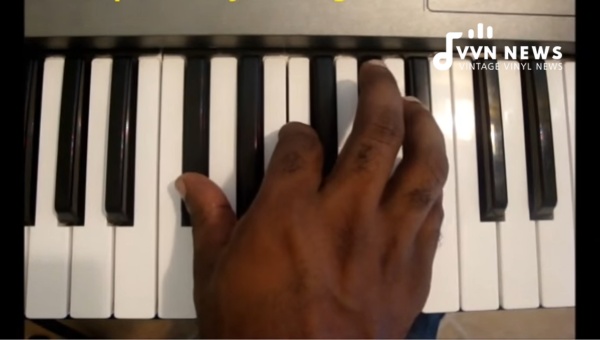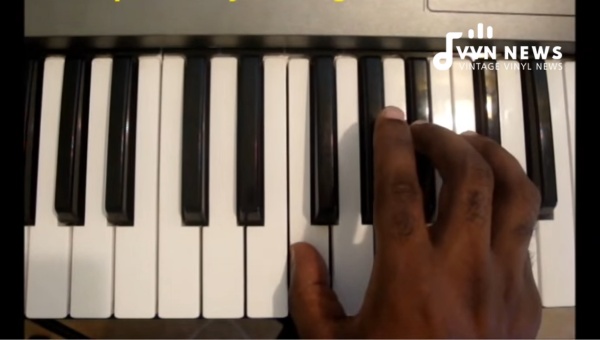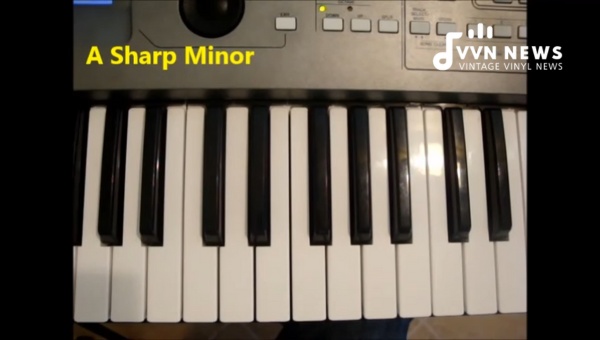As a musician, I have always been fascinated by the subtle nuances and harmonic possibilities that different chord structures can bring to a piece of music.
One particular chord that has intrigued me is the A sharp minor triad. This chord, characterized by its haunting and melancholic sound, adds depth and emotion to any musical composition.
In this article, we will explore the A sharp minor triad in greater detail, discussing its components, characteristics, and how it is commonly used in various genres of music.
Whether you are a music enthusiast or a performer looking to expand your harmonic repertoire, understanding the intricacies of the A sharp minor triad can greatly enhance your musical compositions.
How is an A Sharp Minor Triad defined in musical terms?
An A sharp minor triad, denoted as A#m, is a three-note chord consisting of the root note A#, the minor third C#, and the perfect fifth E#.
It is formed by stacking two intervals of a minor third on top of each other. The A# note is the foundation of this chord, providing its tonal center.
In terms of music theory, a minor triad is characterized by its dark and somewhat melancholic sound.
By lowering the third note of a major triad by one-half step, we can create a minor triad.
The resulting chord has a somewhat somber quality to it compared to its major counterpart.
The A#m chord looks like this:
- Root: A#
- Minor Third: C#
- Perfect Fifth: E#
Understanding these intervals and how they relate to each other is important when exploring the A#m triad and its musical applications.
How are A Sharp Minor Triads characterized?

When it comes to describing the characteristics of A sharp minor triads, there are a few key aspects that stand out:
- Emotional Depth: A sharp minor triads have a melancholic and introspective quality to them. This chord evokes a sense of sadness or longing, making it a powerful tool for expressing complex emotions in music.
- Dark and Mysterious: A sharp minor triad has a dark and mysterious tone that can add tension and intrigue to a musical piece. It is often used in genres such as classical, jazz, and rock to create an eerie atmosphere.
- Versatility: While A sharp minor chords have a naturally solemn sound, they can be utilized in various musical contexts. They work well as both standalone chords and as part of chord progressions, offering flexibility in composition.
- Complementary Chords: In harmonic context, A sharp minor triads can be paired with other chords to create a captivating contrast. For example, combining it with E major or F# major creates an intriguing tension due to the contrasting tonalities.
- Musical Applications: This chord is commonly used in genres such as classical music, jazz ballads, emotional rock ballads, and even certain styles of metal music. Its melancholic nature lends itself well to conveying deep emotions or adding expressive flair to a composition.
A sharp minor triads are characterized by their emotional depth, dark tone, versatility, compatibility with other chords, and a broad range of musical applications across various genres.
By understanding these characteristics, musicians can effectively utilize this chord to create evocative and captivating musical experiences for their listeners.
Also Read: B Flat Minor Triad Guide 2025 [Improve Your Music Theory]
What are the constituent triads of the A Sharp Minor scale? [A#, C#, E#]
The A# minor scale is derived from the natural minor scale and consists of the following notes: A#, B#, C#, D#, E#, F#, G#.
When we take the first (A#), third (C#), and fifth (E#) notes of this scale, we form what is known as the constituent triads of the A# minor scale.
The three main triads that can be formed from the A# minor scale are:
- A Sharp Minor (A#m): This is the tonic chord of the A# minor scale and serves as its home base. It consists of the root note A#, the minor third C#, and the perfect fifth E#. The resulting chord has a dark and melancholic sound that is often used to evoke emotion in various genres of music.
- B Sharp Diminished (B#dim): This is the second triad in the A# minor scale. It comprises the root note B#, a diminished third D, and a diminished fifth F#. The diminished triad has a tense and dissonant sound often used to create tension in musical compositions.
- C Sharp Major (C#): This is an example of a borrowed chord from outside the key signature of A#. It consists of C#, E#, and G#. The major triad has a brighter, more uplifting quality compared to its minor counterpart, which can add contrast and complexity to a musical piece.
Understanding these constituent triads provides a solid foundation for exploring musical compositions in which they can be utilized effectively.
How to produce an A Sharp Minor Triad on Guitar and Piano

To produce an A# minor triad on guitar and piano, you need to understand the layout of the instrument and the positions of the notes.
Here are step-by-step instructions on how to play the A#m triad on both instruments:
On Guitar:
- Start by finding the root note, A#, on your guitar. The A# note is located on the sixth string (the thickest string), at the sixth fret.
- Place your index finger on the sixth fret of the sixth string to hold down the root note.
- Use your middle finger to press down the eighth fret of the fifth string (A string), which is C# – this is your minor third.
- Now, use your ring finger to hold down the ninth fret of the fourth string (D string), which is E# – this serves as your perfect fifth.
- Play all three strings (sixth, fifth, and fourth) simultaneously, making sure that each note rings out clearly.
- Adjust your finger positions if needed to ensure a clean and crisp sound.
On Piano:
- Locate middle C on your piano keyboard; it is typically towards the center of a standard 88-key piano.
- Count up four half steps from C: C# (or Db), D, D#, E — E is our root note for this triad.
- Place your thumb on E as a starting point.
- Skip two keys above E, placing your middle finger on G# (or Ab) — this will be our minor third.
- Skip another two keys above G#, landing your pinky finger on B# (or C) — this will serve as our perfect fifth.
- Press all three keys simultaneously with the appropriate fingers: thumb (E), middle finger (G#), pinky finger (B#).
- Play the notes together to sound the A#m triad, making sure the keys are pressed firmly enough to produce clear tones.
By following these instructions carefully, you will be able to produce an A# minor triad on both guitar and piano.
Remember to practice slowly and gradually build up speed while ensuring accuracy in your finger placement.
Also Read: B Minor Triad [Master Chord Progression In Just Minutes]
Inversions in an A Sharp Minor Triad
Inversions are different ways of rearranging the notes within a chord while still maintaining the same pitches.
They add variety and different tonal colors to your music compositions. A sharp minor triad can be inverted to create three unique voicings, each with its own distinctive sound.
First Inversion (C#m/A#)
The first inversion of the A#m chord involves moving the root note (A#) to the top and bringing the third (C#) down an octave. This creates a new chord where C# becomes the bass note.
The first inversion of A#m looks like this:
- First Inversion: C#m/A#
- C#: Root note
- E#: Minor third
- A#: Perfect fifth
Second Inversion (Emaj/C#)
In the second inversion, we move both the root note (A#) and the third (C#) up one octave, while bringing the fifth (E#) down as the bass note. This inversion creates a unique sound and changes the character of the chord.
The second inversion of A#m looks like this:
- Second Inversion: Emaj/C#
- E#: Root note
- A#: Minor third
- C#: Perfect fifth
Root Position (A Sharp Minor)
The root position is where all three notes of the triad are stacked in their original order. The root note, A#, serves as both the foundation and tonal center of this triad.
The root position of A#m looks like this:
- Root Position: A Sharp Minor
- A#: Root note
- C#: Minor third
- E#: Perfect fifth
Understanding these inversions allows you to explore different sonic possibilities and voicings when incorporating A sharp minor triad into your music compositions.
Experimenting with these inversions can bring variety and depth to your chord progressions.
Also Read: E Flat Minor Triad [How To Crack The Code Of Music Notation]
What are the steps to play A Sharp Minor Triad Inversions on guitar and piano?

Playing inversions of chords adds variety and richness to your musical compositions. Inversions are different voicings of a chord where a note other than the root is played as the lowest note.
They allow for smooth transitions between chords and create interesting harmonies. Here are the steps to play A Sharp Minor Triad inversions on both guitar and piano:
Playing A Sharp Minor Triad Inversions on Guitar:
- Start with the basic A#m chord in open position: Place your index finger on the 1st fret of the B string, your middle finger on the 2nd fret of the D string, and your ring finger on the 3rd fret of the G string. Strum all six strings except for the low E string.
- To play the first inversion, move your index finger from the B string to the low E string, maintaining its position on the 1st fret. Your middle finger should remain on the D string, now at the 3rd fret, while your ring finger stays on the G string at the 4th fret.
- For the second inversion, slide your index finger up to hold down both low E and A strings at the 6th fret. Place your middle finger on D string, 6th fret, and your ring finger stays in position at G string’s 8th fret.
- To play third inversion, use a barre chord shape with your index finger barring all strings at their 11th fret, excluding high E-string (B-string muted). Then place ring and pinky fingers at G-string’s 13th and B-string’s13th respectively.
Playing A Sharp Minor Triad Inversions on Piano:
- Begin by finding an A sharp note (A#) which can be found three white keys to the right of A on the piano.
- For the root position, place your thumb on A#, your middle finger on C#, and your pinky finger on E#. This positions your fingers in a comfortable and compact formation.
- To play the first inversion, shift your thumb up one octave to C#, keeping your middle and pinky fingers in their original positions. You will now have C# as the lowest note, followed by E# and A#.
- In the second inversion, move your thumb up another octave to E#. Your middle finger moves down one white key to A#, while your pinky finger remains on C#. This configuration puts E# at the bottom of the chord structure.
- For playing third inversion, move thumb up by one octave from E# to A#, move middle finger up by two white keys from A# to C#, lastly move pinky finger two white keys further from C# reaching E#.
Understanding these steps will give you the ability to play inversions of the A Sharp Minor Triad effortlessly.
Music pieces featuring A Sharp Minor Triad
The A#m chord, with its dark and melancholic sound, has been used in various musical compositions across different genres.
Its haunting quality adds depth and emotion to these pieces. Here are a few notable examples:
- “Blackbird” by The Beatles – This iconic song by The Beatles features an A#m chord in the intro and throughout the verses. The somber tone of the A#m adds a touch of sadness to the overall feel of the track.
- “Boulevard of Broken Dreams” by Green Day – In this popular rock anthem, Green Day utilizes the A#m chord in the chorus. The chord’s bittersweet quality enhances the introspective lyrics and lends an air of melancholy to the song.
- “In the End” by Linkin Park – Linkin Park’s powerful hit showcases the A#m chord in its pre-chorus sections. The chord choice reflects the emotional intensity of the lyrics and helps create a sense of longing and despair.
- “Someone Like You” by Adele – Adele’s piano-driven ballad prominently features the A#m chord throughout its entirety, contributing to the heart-wrenching atmosphere of unrequited love depicted in the song.
- “Whiskey Lullaby” by Brad Paisley feat. Alison Krauss – This country duet masterfully employs the A#m chord to convey heartbreak and loss in its emotionally charged lyrics.
- “Creep” by Radiohead – Radiohead’s alternative rock anthem makes use of the A#m chord to add a gloomy and introspective element to the song. The chord progression in the chorus, including the A#m, helps create a haunting and memorable melody.
- “Nothing Else Matters” by Metallica – This iconic ballad showcases Metallica’s more melodic side, with the A#m chord featuring prominently in the chord progression. The melancholic tone of the A#m adds depth and emotional intensity to the song.
- “Don’t Speak” by No Doubt – No Doubt’s chart-topping hit utilizes the A#m chord in its chorus, contributing to the emotional weight of the lyrics about heartbreak and loss.
- “Mad World” by Tears for Fears – This 80s synth-pop classic heavily relies on minor chords, including the A#m, to create a somber and introspective atmosphere that perfectly complements the poignant lyrics.
- “When I Was Your Man” by Bruno Mars – In this heartfelt piano ballad, Bruno Mars incorporates the A#m chord into his chord progression, emphasizing feelings of regret and longing in his lyrics.
These are just a few examples of music pieces that feature the A#m chord. By listening to these songs and paying attention to how this triad is used within their context, you can gain a better understanding of how it contributes to their overall mood and emotional impact.
Also Read: D Sharp Minor Triad [Guide To Understanding Music Keys]
FAQs about A Sharp Minor Triad
What is the difference between A#m and Bbm?
A#m and Bbm are enharmonic equivalents, meaning they sound the same but are spelled differently. They share the same notes (A#, C#, and E#) but are named differently depending on the key of the music.
How can I play an A#m chord on guitar?
To play an A#m chord on guitar, place your index finger on the 1st fret of the B string, your middle finger on the 2nd fret of the D string, and your ring finger on the 3rd fret of the G string. Strum all strings except for the low E string.
Can I use an A#m chord in a major key?
Yes, you can use an A#m chord in a major key as a borrowed chord from its parallel minor key. It adds a touch of melancholy or tension that can enhance your composition’s emotional impact.
Are there any famous songs that use A#m?
Yes, there have been numerous popular songs that feature A#m chords. Some notable examples include “My Immortal” by Evanescence and “Green Eyes” by Coldplay.
How can I create interesting progressions using A#m triads?
Experiment with combining A#m triads with other chords from the same key or chromatic alterations to add tension and color to your progressions. Consider exploring modal interchange or secondary dominant concepts for more creative possibilities.
Conclusion
The A sharp minor triad is a distinctive chord that adds depth and emotion to music compositions.
Its haunting and melancholic sound makes it a captivating choice for musicians looking to evoke a particular mood.
By understanding its components and characteristics, musicians can incorporate the A sharp minor triad into their compositions in various genres.
Whether played on the guitar or piano, exploring different inversions and voicings allows for creative and expressive musical possibilities.
So, why not experiment with the unique tonality of the A sharp minor triad and unlock its potential in your own musical journey.








